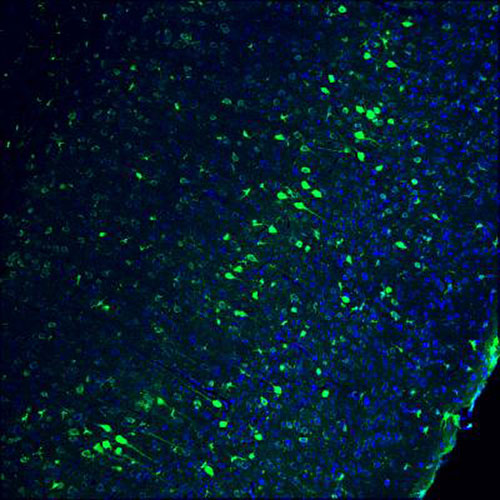![In this image of the adult mouse brain, cell nuclei are blue and genome-edited neurons are green. The image demonstrates the effectiveness of a homology-independent gene-editing technique, which has also shown promise in a rat model of retinitis pigmentosa. [Salk Institute]](https://genengnews.com/wp-content/uploads/2018/08/Nov17_2016_SalkInst_MouseBrain5017124284-1.jpg)
In this image of the adult mouse brain, cell nuclei are blue and genome-edited neurons are green. The image demonstrates the effectiveness of a homology-independent gene-editing technique, which has also shown promise in a rat model of retinitis pigmentosa. [Salk Institute]
A proof-of-concept study has shown that a new genome-editing approach not only works in nondividing cells, it also allows for the efficient and targeted insertion of genes when it is used in animal models. The new approach is called HITI, for homology-independent targeted integration.
HITI looks particularly promising because it opens a largely unused pathway to the targeted genetic revision of live adult organisms. HITI exploits the nonhomologous end-joining (NHEJ) pathway, not the usual homology-directed repair (HDR) pathway. NHEJ, unlike HDR, is active in both dividing and nondividing cells, not just dividing cells, which means that it could enable gene therapies that would focus on nondividing adult cells, such as cells of the eye, brain, pancreas, or heart.
The new HDR-oriented approach was developed by Salk Institute researchers and introduced in an article (“In Vivo Genome Editing via CRISPR/Cas9 Mediated Homology-Independent Targeted Integration”) that appeared November 16 in the journal Nature. Although this article described how HITI was paired with CRISPR/Cas9, it could also be combined with other targeted gene-engineering systems.
“We are very excited by the technology we discovered because it's something that could not be done before,” said Juan Carlos Izpisua Belmonte, a professor in Salk's Gene Expression Laboratory and senior author of the Nature paper. “For the first time, we can enter into cells that do not divide and modify the DNA at will. The possible applications of this discovery are vast.”
Until now, techniques that modify DNA have been most effective in dividing cells, such as those in skin or the gut, using the cells' normal copying mechanisms. The new Salk technology is 10 times more efficient than other methods at incorporating new DNA into cultures of dividing cells, making it a promising tool for both research and medicine. But, more importantly, the Salk technique represents the first time scientists have managed to insert a new gene into a precise DNA location in adult cells that no longer divide
“Based on clustered regularly interspaced short palindromic repeat/Cas9 (CRISPR/Cas9) technology, here we devise a homology-independent targeted integration (HITI) strategy, which allows for robust DNA knock-in in both dividing and non-dividing cells in vitro and, more importantly, in vivo (for example, in neurons of postnatal mammals),” wrote the authors of the Nature article. “As a proof of concept of its therapeutic potential, we demonstrate the efficacy of HITI in improving visual function using a rat model of the retinal degeneration condition retinitis pigmentosa.”
The article describes how the HITI system, which incorporates a nucleic acid cocktail, is delivered by an inert virus. First, HITI components were brought to neurons derived from human embryonic stem cells. Then they were brought to the brains of adult mice. And finally, they were brought to a rat model of retinitis pigmentosa, demonstrating the potential of HITI for gene-replacement therapy.
The Salk Institute team used HITI to deliver to the eyes of 3-week-old rats a functional copy of Mertk, one of the genes that is damaged in retinitis pigmentosa. Analysis performed when the rats were 8 weeks old showed that the animals were able to respond to light, and they passed several tests indicating healing in their retinal cells.
“We now have a technology that allows us to modify the DNA of nondividing cells, to fix broken genes in the brain, heart, and liver,” noted Dr. Izpisua Belmonte. “It allows us for the first time to be able to dream of curing diseases that we couldn't before, which is exciting.”



